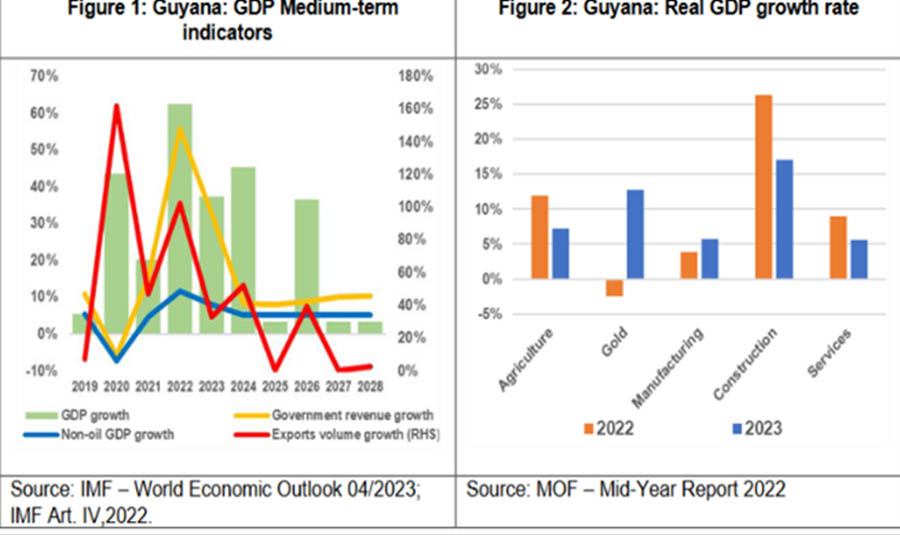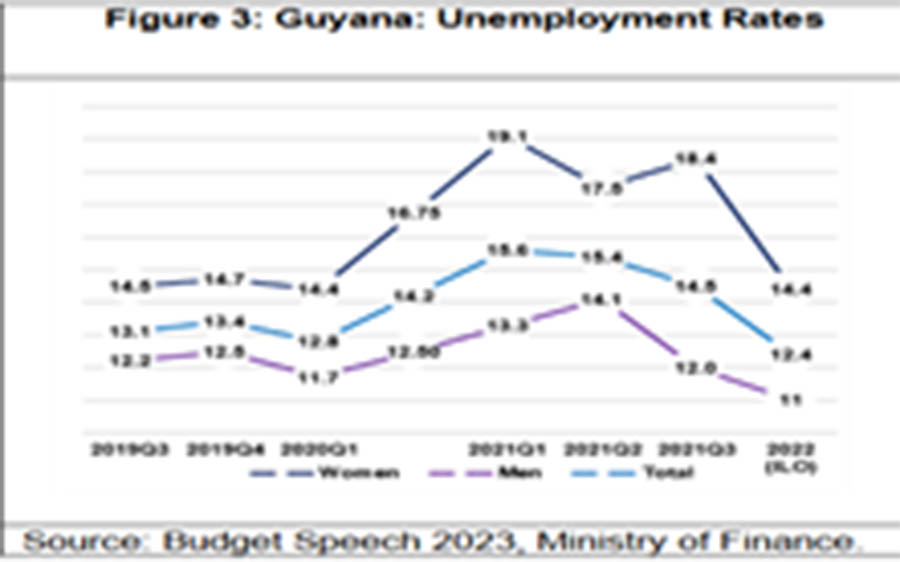According to a new report by the Inter-American Development Bank (IDB), Guyana’s Gross Domestic Product (GDP) growth is expected to expand by 37.2% in 2023, while the non-oil economy which grew by 11.5% in 2022 is projected to grow by 7.9% in 2023.
The report titled “Caribbean Economics – Global & Regional Economies at a Crossroads” noted that Guyana’s GDP grew by 62.3% in 2022, on the back of increased oil production, and is now expected to grow by an additional 37.2% in 2023.
It referenced that the main growth boosters in the non-oil economy in 2022 were agriculture, services, and construction, which grew by 11.9%, 9.0%, 26.3%, respectively.
For 2023, these sectors are projected to grow by 7.2%, 5.6%, and 17%. Gold production, which had contracted by 2.5% in 2022 is expected to recover with a growth rate of 12.7% in 2023.
 IDB Report Caribbean Economies (Guyana)
IDB Report Caribbean Economies (Guyana)
Unemployment rates, which had increased significantly in 2021 during the pandemic, started to move downwards at the end of 2021 according to the report. Initially 15.6% during the first quarter of 2021, the unemployment rate declined by 14.5% during the third quarter of the said year.
The International Labour Organization (ILO) estimated further declines in the unemployment rate in 2022, falling to 12.4%, (11% for men and 14.4% for women).
Labor force participation rates remained stable between 2020 Q1 and 2021 Q3, though there was some variation by gender. The labour force participation of men increased from 60.6% in 2020 Q1 to 64.9% in 2021 Q1, potentially due to more men looking for jobs offsetting job losses within households during the pandemic. The labour force participation rate of men fell back to 62.1% in 2021 Q3. Meanwhile, the labour force participation rate of women fell from 40.9% in 2020 Q1 to 37.8% in 2021 Q3 according to the Guyana Bureau of Statistics.
In 2022, the ILO estimated that the labour force participation of women and men were 39.6% and 61.3%, respectively.
The Bank of Guyana’s monetary policy rate has remained unchanged at 5 % for many years. The reserve requirement ratio, which had been reduced from 12% to 10% in August 2020, as part of the relief measures in the face of COVID-19, climbed to 12% in September 2022.
The Central Bank is entrusted with responsibility for formulating and implementing monetary policy focusing on price stability.
In 2022, the inflation rate reached 7.2% in April, averaged 6.4% over the year, and ended up at7.2% in December. Since then, the inflation rate has progressively declined by 3.0% in May 2023. Food inflation, particularly volatile, was projected at 11.7% in 2022 and incremented to 14.1% in December 2022. It however followed a downward trend in 2023 moving from 12% in January 2023 to 6.4% in May 2023.
The inflation rates for other goods were moderate.
For example, the inflation rates for transportation and communication averaged 2.4% in 2022, while the inflation rate of housing and furniture averaged at 1.7% and 3.8% respectively.
Lending to the private sector and financial indicators
 The IDB report noted that the private sector credit growth increased significantly in 2022, by more than 15% in December. This reached 17% in February and March 2023, before moderating slightly to almost 14% in May 2023.
The IDB report noted that the private sector credit growth increased significantly in 2022, by more than 15% in December. This reached 17% in February and March 2023, before moderating slightly to almost 14% in May 2023.
Of the three major lending categories, lending to businesses experienced significant growth, averaging 20% in 2022, while household credit experienced lower levels of growth averaging 8.8% in 2022 and increasing to 18.5% in May 2023.
Mortgage lending growth averaged at 7.3% in 2022, but eventually mounted to14% in May 2023.
The ratio of non-performing loan to gross loans of commercial banks dropped from 10.8% in 2020 to 4.7% in 2022.
Monetary Policy and Inflation Rate
According to the IDB, in the wake of the current challenges globally, Guyana remains in a unique position benefitting from its newfound sources of revenue as well as resources related to environmental sustainability, such as the sale of carbon credits which places the country in an excellent position to continuously pursue its developmental objectives.
However, the main challenges include the global context of increasing interest rates, affecting the cost of financing, and the development of Guyana’s fiscal framework.
Contextually, the Natural Resource Fund, the medium-term expenditure framework, and the adoption of fiscal balance targets proposed by the IMF are important according to the IDB as savings start to accumulate in the NRF when annual oil revenues exceed US$ 500 million and grow with higher levels of government oil revenues.




